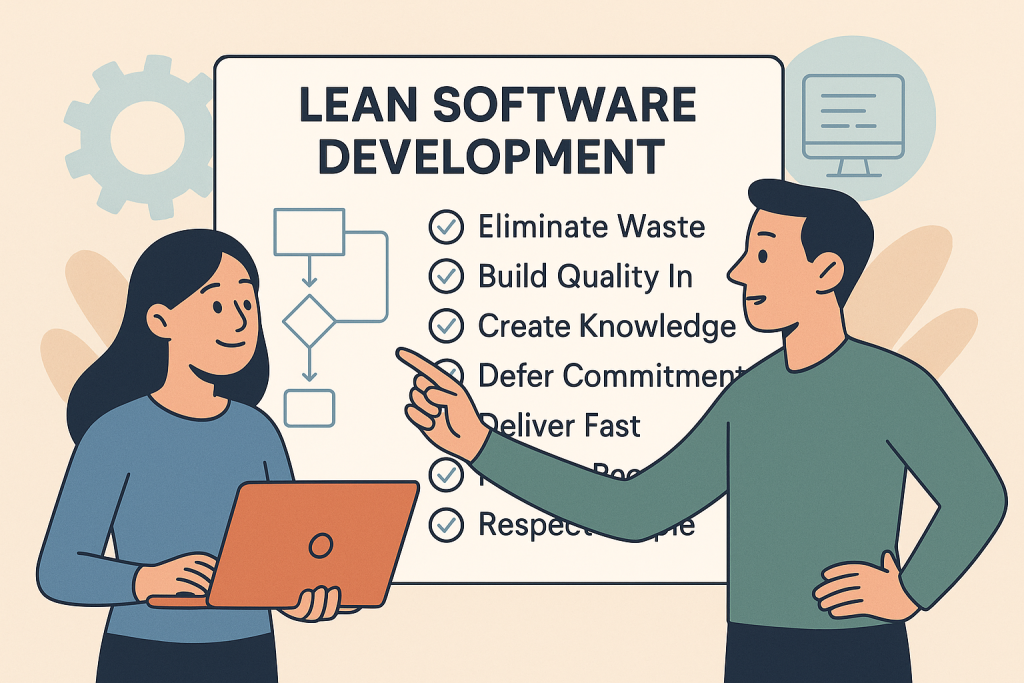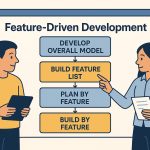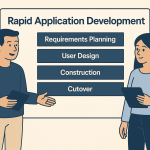In an industry where complexity often masquerades as sophistication, Lean Software Development stands as a refreshing counterpoint. This methodology doesn’t just promise faster delivery or reduced costs—it fundamentally challenges how we think about building software. By borrowing principles from manufacturing and adapting them for the digital age, Lean Software Development has become one of the most pragmatic approaches to creating products that truly matter.
At its heart, this framework represents a philosophy of intentional simplicity. Rather than building elaborate systems loaded with features that may never see the light of day, this approach encourages teams to focus relentlessly on delivering value while systematically eliminating anything that doesn’t serve that purpose. It’s a methodology that resonates particularly well in today’s fast-paced technology landscape, where the ability to pivot quickly and respond to user feedback can make the difference between success and obsolescence.
What is Lean Software Development (LSD)?
Lean Software Development (LSD) is an agile framework built on the principle of optimizing development time and resources while ruthlessly eliminating waste. The methodology’s core philosophy centers on delivering only what the product truly needs, stripping away everything that doesn’t directly contribute to user value or product functionality.
The approach closely aligns with what many recognize as the Minimum Viable Product (MVP) strategy. Teams following Lean principles release the simplest version of their product that still provides meaningful value to users. This isn’t about cutting corners or delivering inferior products—it’s about learning what users actually need before investing resources in building features they might not want.
This creates a powerful feedback loop. Users interact with the basic version of the product, providing real-world data about what works, what doesn’t, and what’s missing. Development teams then use this information to make informed decisions about the next iteration, ensuring that every enhancement addresses genuine user needs rather than assumed requirements.
The emphasis on rapid iteration and continuous learning represents a fundamental shift from traditional waterfall development models, where requirements are locked in early and changes become increasingly expensive to implement. Lean Software Development embraces change as not just inevitable but desirable, viewing it as an opportunity to create better products.
What’s the History of Lean Software Development (LSD)?
The story of Lean Software Development begins not in Silicon Valley, but on the factory floors of post-war Japan. In the 1950s, Toyota faced a unique challenge: how to compete with established American automakers while operating with significantly fewer resources. Their response was revolutionary—they developed what came to be known as the Toyota Production System, a methodology focused on eliminating waste and maximizing value at every step of the manufacturing process.
The genius of Toyota’s approach lay in its definition of waste. Any activity that didn’t directly contribute to the functionality, quality, or delivery of the final product was considered wasteful and therefore a candidate for elimination. This meant scrutinizing everything from inventory management to worker movements, constantly asking the question: “Does this add value for the customer?” Any action that did not impact the functionality of the car being built and delivered was considered waste under this system, and therefore removed from the process.
The success of this system was undeniable. Toyota’s production became more efficient, their quality improved, and their ability to respond to market changes increased dramatically. Other manufacturing organizations across many industries took notice and began adopting these principles. What began as the Toyota Production System eventually evolved into the broader Lean manufacturing movement that spread worldwide, and the name later changed simply to “Lean.”
The transition from manufacturing to software came in 2003 with the publication of the now-famous book “Lean Software Development.” This seminal work translated manufacturing principles into the context of software creation, recognizing that while the medium was different, the fundamental challenges of eliminating waste and maximizing value remained remarkably similar. The methodology was first applied to software creation through this publication, marking the beginning of a new approach to development that would influence countless teams and organizations.
What are the Strengths and Weakness of Lean Software Development?
Understanding both the advantages and limitations of Lean Software Development is crucial for teams considering this approach. Like any methodology, LSD works exceptionally well in certain contexts while presenting challenges in others.
The strengths of Lean Software Development are compelling and address many common pain points in software creation. The streamlined approach enables teams to deliver functionality more quickly by focusing efforts on what truly matters. When unnecessary activities are eliminated, development cycles become shorter and more predictable, allowing teams to respond rapidly to market changes and user needs.
Cost reduction represents another significant benefit, though it occurs through efficiency rather than simply cutting resources. By avoiding the development of unused features and minimizing rework through early user feedback, organizations often find their development budgets stretching further while producing better results. The methodology also eliminates unnecessary activity, which naturally reduces both time and financial investments in non-value-adding work.
Perhaps most importantly, Lean Software Development empowers the development team to make decisions autonomously. This empowerment serves multiple purposes: it accelerates development by reducing the time between identifying a problem and implementing a solution, and it tends to boost morale and engagement. When developers feel trusted to make important decisions and see the direct impact of their choices on the final product, they often become more invested in the project’s success.
LSD’s strengths include:
- Streamlined approach allows more functionality to be delivered in less time
- Eliminates unnecessary activity, and as a result, can reduce costs
- Empowers the development team to make decisions, which can also boost morale
However, the methodology’s weaknesses deserve equal consideration. Lean Software Development heavily depends on the team involved, making it not as scalable as other frameworks. A highly skilled, cohesive team might thrive under Lean principles, while a less experienced team could struggle with the responsibility and pace. This dependency on team quality can make it challenging to implement across large organizations or teams with varying skill levels.
Documentation presents another significant challenge. The methodology depends on strong documentation, and failure to do so can result in development mistakes. While Lean principles encourage minimizing unnecessary documentation, teams must still maintain enough records to ensure knowledge continuity and prevent costly errors. Striking the right balance requires judgment and experience that not all teams possess initially.
The iterative nature of Lean development can also create challenges in organizations that prefer predictable timelines and fixed requirements. Stakeholders accustomed to traditional project management approaches might find the uncertainty and frequent changes unsettling, even when these changes ultimately lead to better products.
LSD’s weaknesses include:
- Heavily depends on the team involved, making it not as scalable as other frameworks
- Depends on strong documentation, and failure to do so can result in development mistakes
Should You Use Lean Software Development?
The decision to adopt Lean Software Development shouldn’t be made lightly or universally. This methodology works best in specific contexts and with particular types of teams and products. Many organizations have found the LSD methodology to be an excellent approach to software development because of its streamlining of the process and forcing the team to ruthlessly cut away any activity that doesn’t directly affect the final product.
Organizations with experienced development teams who have demonstrated the ability to make good decisions under pressure often find Lean approaches most effective. The methodology’s emphasis on team empowerment and rapid decision-making requires individuals who can handle responsibility and uncertainty while maintaining focus on delivering value.
Products with uncertain market requirements or rapidly evolving user needs also benefit from Lean principles. The methodology’s emphasis on rapid iteration and user feedback makes it particularly valuable when building innovative products or entering new markets where assumptions are likely to be wrong. The MVP approach allows teams to test hypotheses quickly and adjust course based on real user behavior rather than internal speculation.
However, an organization must have an outstanding development team, and trust that team implicitly, for this approach to be successful. This trust extends beyond technical capabilities to include judgment, communication skills, and the ability to make decisions that balance short-term pressures with long-term product vision.
Conversely, projects with strict regulatory requirements, fixed specifications, or situations where the cost of mistakes is extremely high might benefit from more traditional, documentation-heavy approaches. The key is matching the methodology to the specific context and constraints of the project and organization.
The success of Lean Software Development ultimately depends on an organization’s willingness to embrace uncertainty, trust their teams, and prioritize learning over adherence to initial plans. This cultural shift can be as challenging as any technical implementation, but organizations that successfully make this transition often find themselves better positioned to respond to market changes and deliver products that users actually want. The methodology doesn’t just change how software is built—it changes how teams think about the relationship between building, learning, and delivering value.
Conclusion
Lean Software Development represents more than just another methodology in the ever-expanding toolkit of software creation approaches. It embodies a fundamental philosophy about how we should approach building products in an uncertain world: with humility, focus, and an unwavering commitment to delivering genuine value. While not appropriate for every situation or team, when applied thoughtfully by capable teams in the right context, Lean principles can transform not just the efficiency of development processes, but the quality and relevance of the products themselves. Perhaps most importantly, it reminds us that in software development, as in manufacturing, the goal isn’t to build more—it’s to build better.


